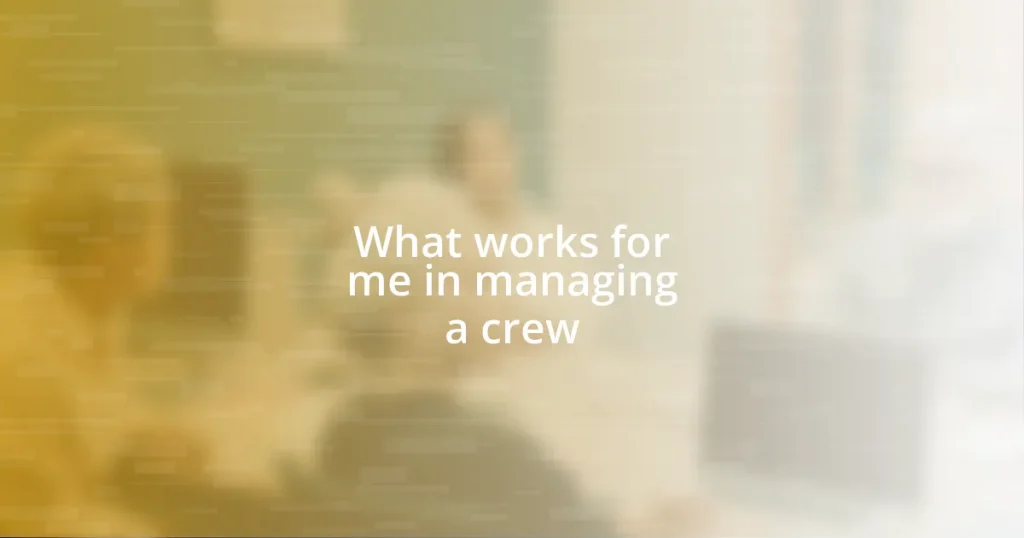Key takeaways:
- Clear communication is essential for effective crew management, preventing confusion and fostering trust.
- Establishing clear roles and responsibilities boosts accountability and enhances team confidence.
- Implementing regular check-ins and utilizing multiple communication channels improves clarity and team dynamics.
- Adapting management styles to individual team member needs fosters a supportive and productive environment.
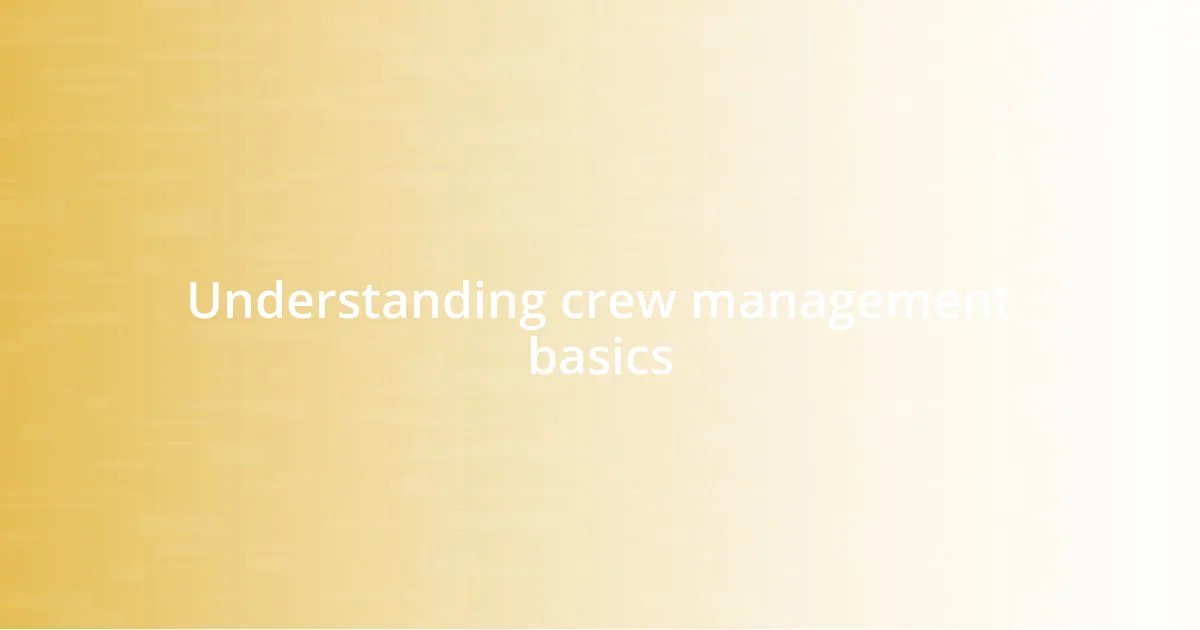
Understanding crew management basics
Effective crew management starts with clear communication. I remember a time when a lack of clarity led to confusion on a project. I learned that when expectations aren’t explicitly outlined, even the most skilled teams can falter. Isn’t it fascinating how just a few miscommunications can unravel a whole plan?
Building strong relationships within the crew is another crucial aspect. I’ve found that taking time to know each member personally not only enhances trust but also boosts morale. When I invested in understanding their strengths and weaknesses, our productivity soared. This personal connection transforms a group of individuals into a cohesive team, don’t you think?
Moreover, proactive problem-solving is vital in crew management. I vividly recall a situation where innovative brainstorming during a team meeting turned around a challenging project. Instead of dwelling on difficulties, I encouraged everyone to share ideas, making it a collective effort. This experience taught me that when the crew feels empowered to contribute, solutions often emerge organically. How can we leverage each other’s insights to create a more effective workflow?
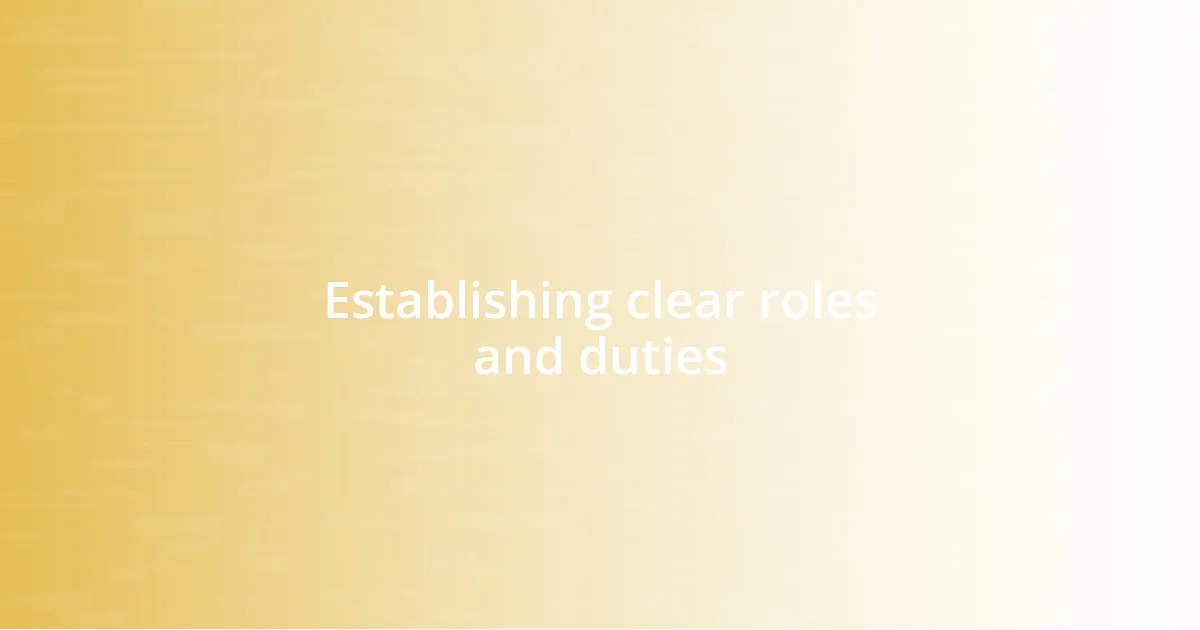
Establishing clear roles and duties
Establishing clear roles and duties is the backbone of any efficient crew. I recall a project where we faced chaos because no one truly understood their responsibilities. It was a turning point for me. When I took the time to delineate who was handling what, everything fell into place. Suddenly, our workflow became smoother, and team members were more confident in what they needed to achieve.
- Clearly define each role in team meetings.
- Create a visual chart of roles and responsibilities.
- Regularly review and adjust roles as projects evolve.
- Encourage ownership by allowing individuals to voice how they can best contribute.
- Celebrate successes tied to specific roles to boost confidence and motivation.
In my experience, clarity not only promotes accountability but also fosters a sense of pride among team members. Everyone wants to feel like a vital part of the mission, and when roles are clearly established, that’s exactly what happens.
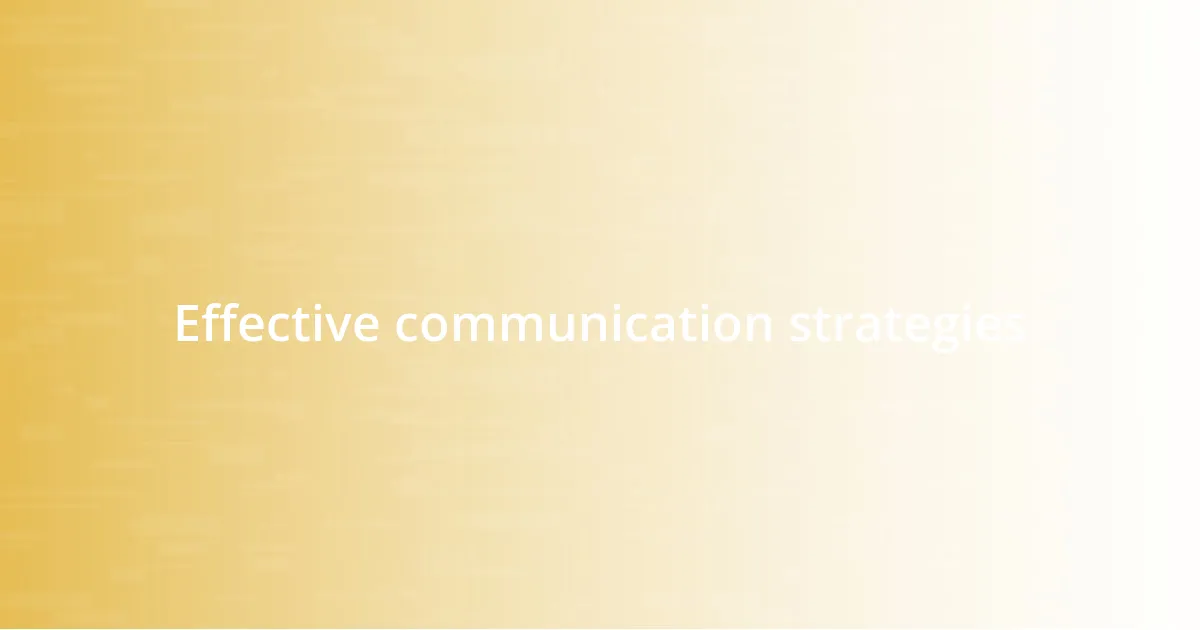
Effective communication strategies
Effective communication is the linchpin of successful crew management. I remember a time when our crew was facing a tight deadline, and I noticed the stress levels rising. I decided to implement daily check-ins, where everyone could voice their concerns and share their progress. Surprisingly, not only did it ease tensions, but it also fostered an open environment where ideas flowed freely. Have you ever experimented with something simple that transformed your team’s dynamic?
In my experience, utilizing different communication channels can greatly enhance clarity. For instance, I embraced both informal and formal means. While emails kept everyone informed, quick chats or video calls helped maintain a personal touch. Once, a short team huddle clarified a critical detail about our project, saving us from potential setbacks. I find that balancing various forms of communication not only accommodates different preferences but also ensures no one feels left out.
Receiving feedback is sometimes overlooked but incredibly powerful. I implemented a system for anonymous suggestions within my crew, aiming at encouraging honest communication. You wouldn’t believe the insights we gained! I still recall reading a note that highlighted a minor frustration. That small yet significant change improved our workflow immensely. By actively inviting feedback, we not only resolved issues but also empowered team members to take ownership of their thoughts and contribute meaningfully.
| Effective Strategy | Description |
|---|---|
| Daily Check-ins | Short, consistent meetings to discuss progress and alleviate concerns. |
| Multiple Communication Channels | Utilizing both formal (emails) and informal (video calls) methods to enhance clarity. |
| Anonymous Feedback | Encouraging crew members to share concerns or ideas without fear of judgment. |
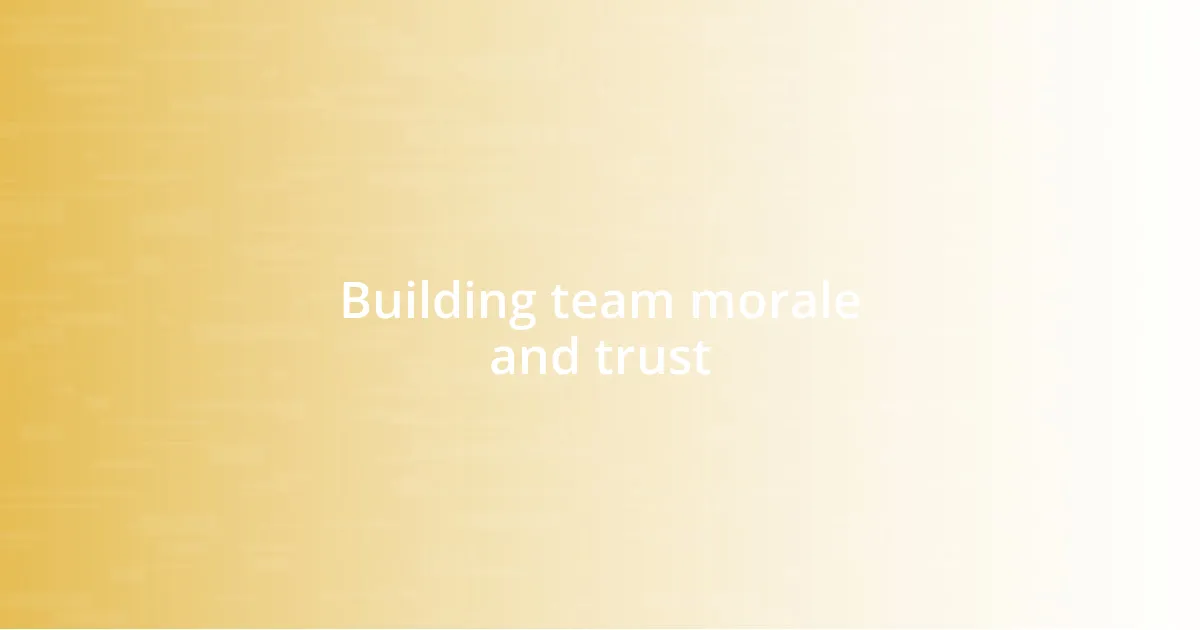
Building team morale and trust
Building team morale and trust is something I view as essential in steering any crew towards success. I always remember a project where things felt a bit sterile and routine. I decided to introduce casual team lunches, where everyone could relax and just chat. It was a small gesture, but it broke down barriers and allowed team members to see each other as more than just colleagues. Have you ever witnessed how a simple meal can ignite connections?
Alongside building relationships, I’ve learned that recognizing individual contributions can uplift morale significantly. Once, I took the time to spotlight someone’s innovative idea during a team meeting. The joy on their face was priceless, and I noticed how it inspired others to share their thoughts more openly. It created this ripple effect of encouragement that just wouldn’t stop. Don’t you think everyone deserves a moment in the spotlight now and then?
Lastly, trust within a team blossoms when members feel they can rely on one another. I recall the time we faced a significant challenge, and instead of pointing fingers, we huddled together to brainstorm solutions as a cohesive unit. It was in that moment of vulnerability that I felt our bond strengthen. Trust isn’t just built; it’s nurtured through shared experiences and tackling challenges as a team. Who wouldn’t want to be part of a crew that faces obstacles head-on together?
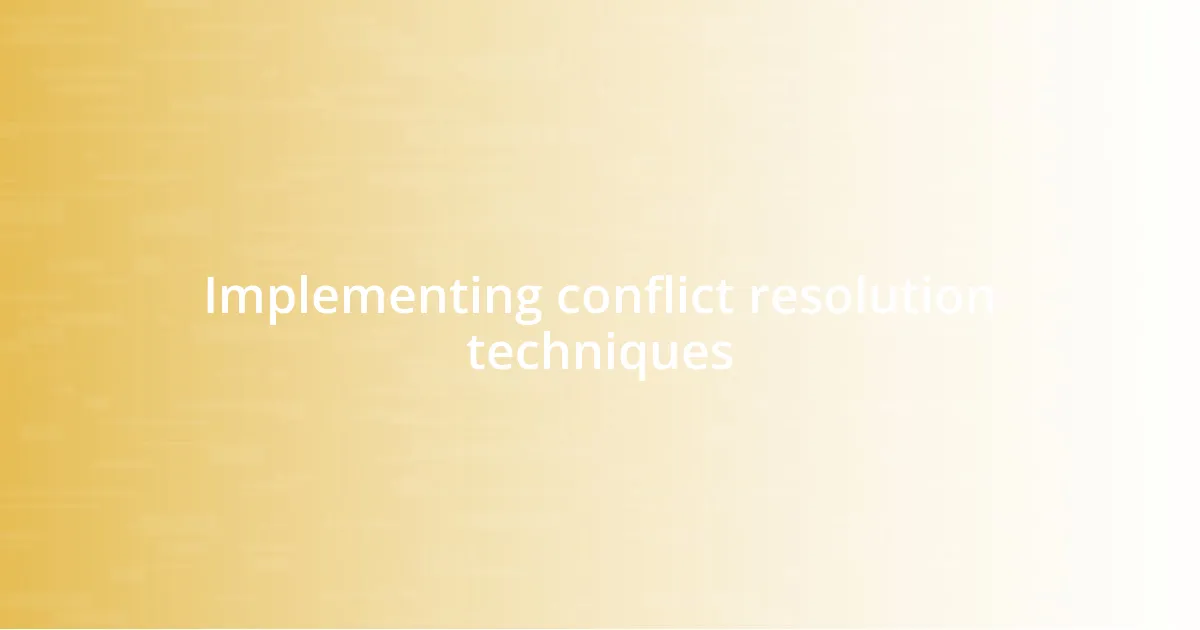
Implementing conflict resolution techniques
When it comes to implementing conflict resolution techniques, I find that keeping lines of communication open is paramount. There was a time when two team members couldn’t see eye-to-eye on a project approach. Instead of letting tensions simmer, I facilitated a neutral brainstorming session. Seeing them share their perspectives directly in a safe environment was eye-opening. Have you ever been in a situation where direct dialogue revealed unexpected common ground?
In my experience, mediation is a powerful tool. I once found myself in the middle of a heated disagreement regarding task delegation. I took the opportunity to step in as a mediator, guiding the discussion by asking open-ended questions. This approach not only helped clarify misunderstandings but also reinforced the idea that we were all on the same team. Isn’t it fascinating how often conflicts arise from miscommunication rather than genuine disagreement?
Finally, I’ve learned that developing a structured conflict resolution process is crucial. After a particularly challenging project, we created a clear framework to address disputes as they arise. This included steps for discussing issues, agreeing on solutions, and following up to ensure resolution. The peace of mind this provided was palpable; team members felt empowered to address conflicts head-on, knowing they had a system to lean on. Isn’t that a relief, knowing you’re not navigating these waters alone?
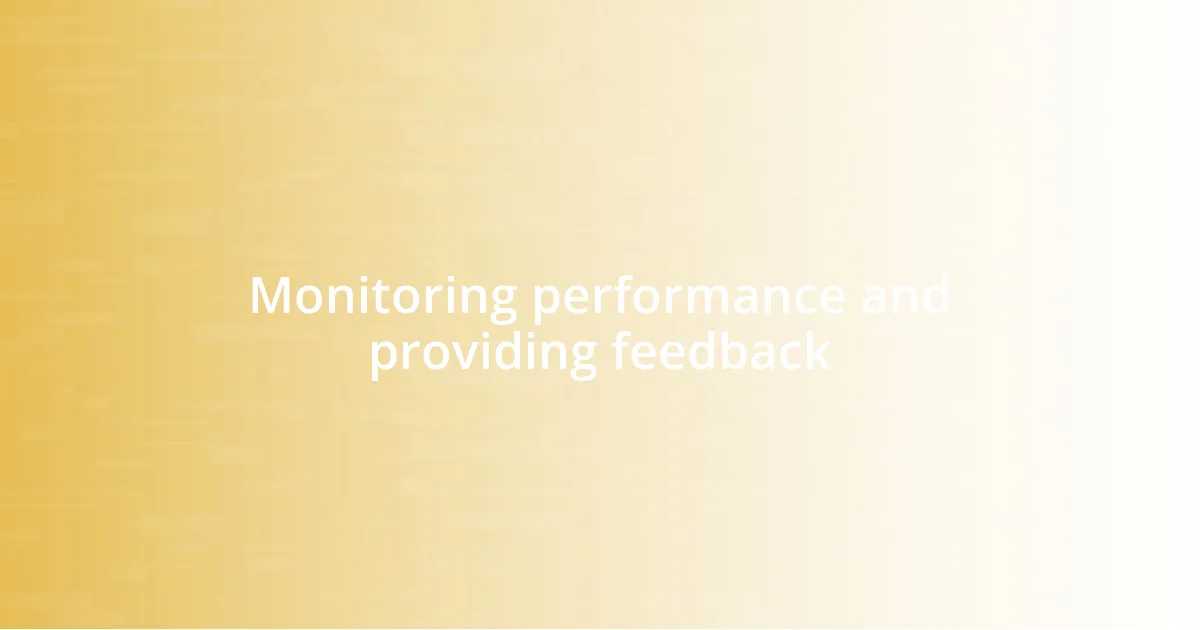
Monitoring performance and providing feedback
Monitoring performance is a fundamental aspect of managing any crew effectively. I remember a time when I implemented weekly check-ins to gauge our progress on a project. At first, I was met with some resistance—who wants more meetings, right? However, as I encouraged open dialogue during these sessions, I started seeing the team’s anxiety wane as they felt more in control of our goals and their responsibilities. Have you noticed how a little bit of structure can really clarify expectations?
Providing feedback is equally important, and I find that it’s most impactful when it’s timely and specific. During one project, a team member was struggling with their tasks, and instead of waiting until the end to address it, I offered constructive feedback right then and there. It was astonishing to see how quickly they improved—not only did they appreciate the immediate guidance, but it also reinforced our shared commitment to quality. Isn’t it amazing how just a few words can transform someone’s performance?
Finally, I believe that feedback shouldn’t just be about correcting mistakes; it’s also about celebrating success. After a particularly tough phase of a project, I made it a point to recognize the team’s achievements in our performance reviews. I’ll never forget the smiles and sense of pride that lit up the room. This practice not only boosted morale but fostered a culture where everyone felt their contributions were valued. Don’t you think it’s vital that we acknowledge each other’s hard work and dedication?
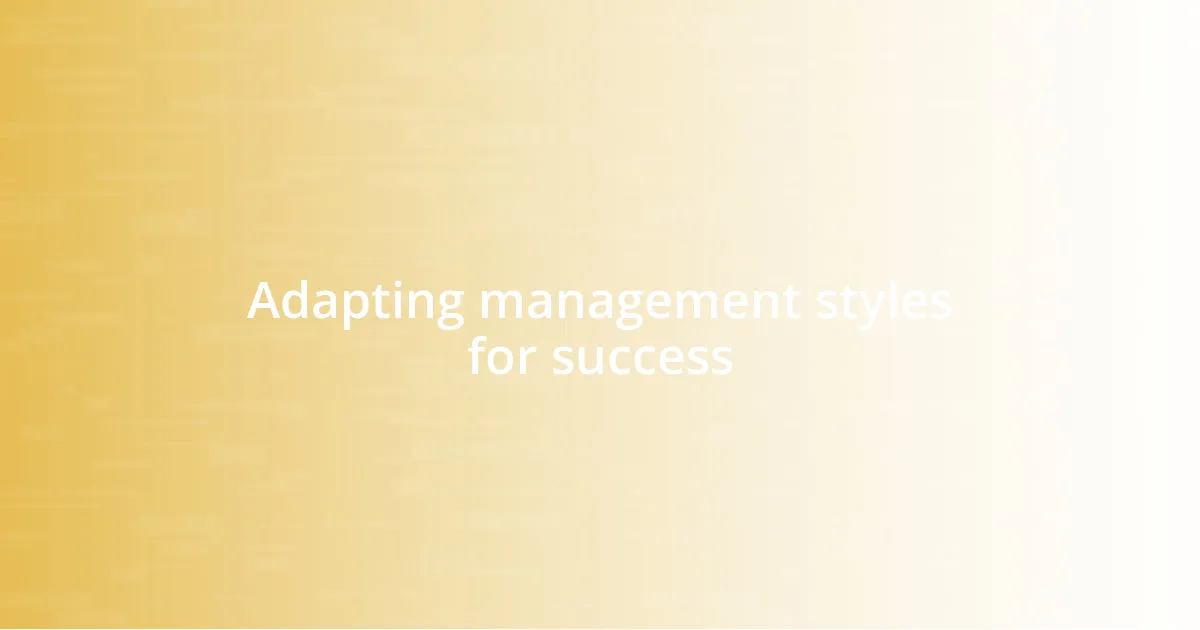
Adapting management styles for success
Adapting my management style has been essential for fostering a productive team environment. There was a time when my previously hands-on approach wasn’t connecting with everyone. I realized that some team members thrived with more autonomy, so I shifted my strategy to offer guidance without micromanagement. Have you ever noticed how a little trust can spark creativity and boost morale in unexpected ways?
I also discovered the value of flexibility in response to different situations. During a high-pressure project, the team faced burnout, and I recognized the need for a supportive approach. I organized a series of brief, focused huddles to check on everyone’s well-being, which allowed us to make adjustments without losing sight of our goals. Isn’t it amazing how taking a moment to check in can reenergize the entire group?
Ultimately, I’ve learned that staying attuned to individual preferences is key to effective management. I recall one case where a quieter team member thrived with one-on-one coaching rather than group discussions. Tailoring my approach not only helped them shine, but it also strengthened our overall dynamic. Don’t you think that recognizing and valuing different styles can lead to greater team cohesion?










